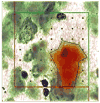Caloric restriction attenuates amyloid deposition in middle-aged dtg APP/PS1 mice
- PMID: 19699265
- PMCID: PMC2748166
- DOI: 10.1016/j.neulet.2009.08.038
Caloric restriction attenuates amyloid deposition in middle-aged dtg APP/PS1 mice
Abstract
Caloric restriction (CR) mitigates neurological damage arising from aging and a variety of other sources, including neuropathology in young adult mice that express single and double transgenic (tg) mutations associated with Alzheimer disease (AD). To evaluate the potential of CR to protect against relatively heavy AD-type pathology, middle-aged (13-14-month-old) mice that co-express two mutations related to familial AD, amyloid precursor protein (APP) and presenilin 1 (PS1), were fed balanced diets with 40% fewer calories than ad libitum-fed controls. Following 18 weeks of treatment, mice were killed and brains were processed for quantification of total volume of amyloid-beta (Abeta) in the hippocampal formation and the overlying neocortex. Computerized stereology confirmed that CR reduced the total Abeta volume by about one-third compared to that in age-matched controls. Thus, CR appears to attenuate the accumulation of AD-type neuropathology in two cortical brain regions of middle-aged dtg APP/PS1 mice. These findings support the view that CR could be a potentially effective, non-pharmacology strategy for reducing relatively heavy Abeta deposition in older adult dtg APP/PS1 mice, and possibly afford similar protection against the onset and progression of AD in older adult humans.
Figures


Similar articles
-
Long-Term Caloric Restriction Attenuates β-Amyloid Neuropathology and Is Accompanied by Autophagy in APPswe/PS1delta9 Mice.Nutrients. 2021 Mar 18;13(3):985. doi: 10.3390/nu13030985. Nutrients. 2021. PMID: 33803798 Free PMC article.
-
The effect of focal brain injury on beta-amyloid plaque deposition, inflammation and synapses in the APP/PS1 mouse model of Alzheimer's disease.Exp Neurol. 2015 May;267:219-29. doi: 10.1016/j.expneurol.2015.02.034. Epub 2015 Mar 4. Exp Neurol. 2015. PMID: 25747037
-
GEPT extract reduces Abeta deposition by regulating the balance between production and degradation of Abeta in APPV717I transgenic mice.Curr Alzheimer Res. 2009 Apr;6(2):118-31. doi: 10.2174/156720509787602942. Curr Alzheimer Res. 2009. PMID: 19355846
-
Catecholaminergic neuronal loss in locus coeruleus of aged female dtg APP/PS1 mice.J Chem Neuroanat. 2007 Nov;34(3-4):102-7. doi: 10.1016/j.jchemneu.2007.05.008. Epub 2007 May 31. J Chem Neuroanat. 2007. PMID: 17658239 Free PMC article.
-
The Effects of Peripheral and Central High Insulin on Brain Insulin Signaling and Amyloid-β in Young and Old APP/PS1 Mice.J Neurosci. 2016 Nov 16;36(46):11704-11715. doi: 10.1523/JNEUROSCI.2119-16.2016. J Neurosci. 2016. PMID: 27852778 Free PMC article.
Cited by
-
Metabolic mystery: aging, obesity, diabetes, and the ventromedial hypothalamus.Trends Endocrinol Metab. 2013 Oct;24(10):488-94. doi: 10.1016/j.tem.2013.05.007. Epub 2013 Jun 20. Trends Endocrinol Metab. 2013. PMID: 23791973 Free PMC article.
-
Caloric restriction leading to attenuation of experimental Alzheimer's disease results from alterations in gut microbiome.CNS Neurosci Ther. 2024 Jul;30(7):e14823. doi: 10.1111/cns.14823. CNS Neurosci Ther. 2024. PMID: 38992870 Free PMC article.
-
Long-Term Caloric Restriction Attenuates β-Amyloid Neuropathology and Is Accompanied by Autophagy in APPswe/PS1delta9 Mice.Nutrients. 2021 Mar 18;13(3):985. doi: 10.3390/nu13030985. Nutrients. 2021. PMID: 33803798 Free PMC article.
-
Intraventricular hemorrhage induces deposition of proteoglycans in premature rabbits, but their in vivo degradation with chondroitinase does not restore myelination, ventricle size and neurological recovery.Exp Neurol. 2013 Sep;247:630-44. doi: 10.1016/j.expneurol.2013.02.018. Epub 2013 Mar 6. Exp Neurol. 2013. PMID: 23474192 Free PMC article.
-
A dietary regimen of caloric restriction or pharmacological activation of SIRT1 to delay the onset of neurodegeneration.J Neurosci. 2013 May 22;33(21):8951-60. doi: 10.1523/JNEUROSCI.5657-12.2013. J Neurosci. 2013. PMID: 23699506 Free PMC article. Clinical Trial.
References
-
- Edossa A, Kalifa S, Polston EK, Mouton PR, Manaye KF. AD-type degeneration of pyramidal cells in hippocampus of dtg APP/ PS1 mice. Soc Neurosci Abstr. 2008;638
-
- Arendash GW, Garcia MF, Costa DA, Cracchiolo JR, Wefes IM, Potter H. Environmental enrichment improves cognition in aged Alzheimer's transgenic mice despite stable B-amyloid deposition. Neuroreport. 2004;15:1751–1754. - PubMed
-
- Barberger-Gateau P, Letenneur L, Larrieu S, Dartigues JF. Dietary fat and dementia: Data from PAQUID. J Neurol Sci. 2005;229:372–372.
-
- Bondolfi L, Ermini F, Long JM. Impact of age and caloric restriction on neurogenesis in the dentate gyrus of C57bl/6 mice. Neurobiol Aging. 2004;25:333–340. - PubMed
-
- Borchelt DR, Thinakaran G, Eckman CB, et al. Familial Alzheimer's disease-linked presenilin 1 variants elevate A beta 1-42/1-40 ratio in vitro and in vivo. Neuron. 1996;17:1005–1013. - PubMed
Publication types
MeSH terms
Substances
Grants and funding
LinkOut - more resources
Full Text Sources
Other Literature Sources
Medical
Miscellaneous

